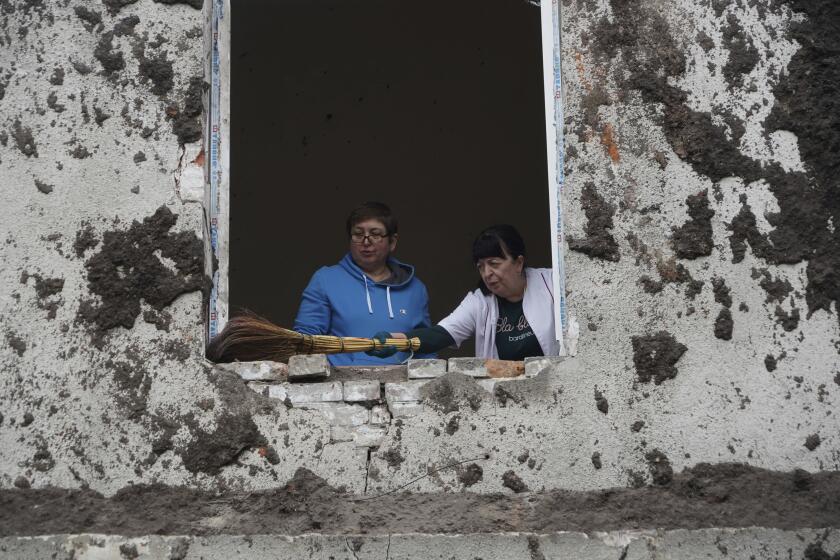Vaccinate or risk it? Parents weigh choice One option: taking their chances
Tammy Reed, the 28-year-old mother of a toddler, is not given to belief in conspiracy theories and is not the type to be rattled by the phrase “pandemic flu.” The Menifee, Calif., resident is the kind of mom who gathers a good deal of her medical intelligence on government websites, trusts a friend who is a nurse practitioner and is raising her bright, strong-willed daughter with all the confidence of a former nanny and the second-born in a family of six.
She’s the kind of mom who thinks that when the vaccine for H1N1 influenza becomes available for her daughter, she may just take a pass on it.
“It’s a different brand of flu, but it is still the flu, and I think she’s already built a pretty strong immune system,” Reed says of her blond, blue-eyed 14-month-old. At the same time, the tests on the vaccine in development against H1N1 aren’t even completed yet, and that, to Reed, sounds like a formula for unforeseen problems down the road.
“I’m really more concerned about the long-term effects and lifelong damage it could do to her,” Reed says.
So for now, at least, she’s made her peace with the prospect that her daughter, Coral, could have a few miserable days and a lifetime immunity from this novel strain of flu.
She’ll seek her pediatrician’s opinion next month when Coral is due for a checkup, Reed says. “But I don’t think it’ll sway me at this point.”
As the nation braces for a season of pandemic contagion, omnipresent vaccine clinics and debate over healthcare reform, the myriad doubts of parents and citizens like Reed represent a new and potent strain of vaccine ambivalence.
Physicians say they are hearing young parents -- many of whom have neither seen nor suffered any of the once-common diseases of childhood -- express doubts about inoculating their children against the novel strain of influenza.
This new generation of vaccine skeptics has been forged by the stubbornly persistent belief -- discredited by a welter of studies -- in a link between vaccines and autism. And it is further fueled by a combustible mix of distrust of drug manufacturers, media outlets and the federal government.
And although many pediatricians are readying stern lectures in support of vaccinating children, several in Southern California contacted by The Times acknowledged they have doubts about recommending a vaccine that is still in testing for all of their young patients.
“A significant proportion of our population don’t want to get it,” says Sherman Oaks pediatrician Mikayel Abramyan. “I don’t even know whether I will advocate for it right now.”
To date, notes Abramyan, who saw a fair amount of novel H1N1 over the summer, the illness has been mild, and many parents of the children he cares for “want them to get their immunity that way instead of a flu shot,” he says. While Abramyan says he rarely lets such preferences go unchallenged, “it’s a reasonable position, and I understand it on an individual level. . . . I understand where they’re coming from.”
--
New generation
Americans in their 20s, 30s and 40s have been largely spared the yearly deliberations over seasonal flu vaccine, either for themselves or their kids. School-aged children and their parents are mostly in robust health. Until very recently, they have been an afterthought in vaccination drives, which have focused instead on reaching the very old and very young -- populations considered at highest risk of complications from seasonal flu.
The new H1N1 virus has changed all that. Epidemiologists have found that children, young adults and pregnant women who catch the new flu run a greater risk than the elderly of developing complications; as a result, all three groups top the list of those recommended to get H1N1 vaccine this year. And even before the new strain emerged, many epidemiologists had embraced the view that vaccinating schoolchildren -- the most prolific spreaders of germs -- might be the best way to reduce the seasonal flu’s hold on the entire population.
The collective doubts of this generation of parents, say experts in infectious disease control, could stymie the efforts of government officials and the medical establishment to stem the spread of a new contagion, and to ready for other infectious diseases that may emerge down the road.
“Swirling around parents this fall will be a lot of myths, misinformation and legitimate and factual communications,” says Sandra Quinn, a University of Pittsburgh public health professor who recently completed a national survey of attitudes about the flu vaccine. Of all the messages parents of young children are receiving, Quinn says, the parents of young children seem to be fixating on the word “uncertainty” -- about the severity and scope of the flu, the status of the vaccine and the need for mass vaccinations.
These adults have never been an easy sell on flu vaccine for themselves, either. Even among adults 18-49 with chronic health conditions -- a population urged by government health officials to get vaccinated against seasonal flu -- only 37% last year got a flu shot or flu mist.
Susanne Stuart-Nystrom, a 37-year-old Venice resident whose son Robert entered preschool for the first time Thursday, is among those weighing the decision to vaccinate her child against the novel H1N1 flu.
Just a month short of 3 years old, Robert is healthy, but has had some food allergies that were first thought to be asthma. Asthmatic children, as well as those who have diabetes, cerebral palsy or other heart or lung conditions are recommended to be among the first to get the vaccine. But Stuart-Nystrom, who feels confident that her son’s “asthmatic” episode has been managed by dietary changes, says that she too will probably take a pass on vaccinating her child when the time comes.
“I haven’t seen enough evidence to show that swine flu is as deadly and as scary as it’s made out to be,” says Stuart-Nystrom, who last week was fighting a respiratory infection. Stuart-Nystrom thinks that media outlets have whipped up the threat in a bid to gain viewers. And “anything brought out by big business, by corporations, that makes me wary for sure. . . . I’m not sure they have our interests in mind.”
Nor is the Venice mother confident that the Food and Drug Administration can reliably assure the overall safety of the vaccine. Pointing to a recent spate of contaminated-food recalls, she said that the FDA’s relationship with the industries it regulates may be too close for the agency to operate effectively as an honest broker.
She also voiced the widely held belief that immunity acquired the natural way -- through a child’s having caught an illness -- is stronger and longer-lasting than that acquired by vaccination. That claim is much debated among physicians and infectious-disease specialists, with evidence falling on both sides of the debate.
--
Wider suspicion
In approaching childhood vaccines in general, neither Stuart-Nystrom nor Reed is reflexively against them. Each woman has had her child immunized against a wide range of childhood diseases. But each has also decided to wait, at least, for her child to get older before getting the vaccine cocktail that immunizes against measles, mumps and rubella. Though the MMR vaccine has not been formulated with the preservative thimerosol since 2001, it remains a common source of concern among parents, because many families of children with autism, as well as vaccine refusers, have charged that the MMR vaccine is the cause of the developmental disorder.
Some formulations of the H1N1 influenza vaccine are expected to contain a small amount of thimerosol to prevent contamination during manufacture and shipment. The American Academy of Pediatrics, in an effort to blunt these and other concerns, recently posted to its website an exhaustive accounting of studies that have failed to link thimerosol with harm. But the preservative’s low-level presence in some flu vaccines, including some H1N1 formulations that will be offered for children this year, may make some pediatricians and parents squeamish. Some parents will seek out formulations that are free of the preservative, but others may just stay away.
Finally, there is the hassle factor. As busy parents ponder the prospect of bringing their kids to the doctor twice -- once for a seasonal flu shot and again for the H1N1 vaccine -- some are expected to take their chances with less vaccine than recommended. If the H1N1 flu appears to have run its course before vaccine becomes available, many parents may decide their kids can skip both vaccines altogether.
“Complacency is a big challenge,” Dr. Anne Schuchat, director of CDC’s National Center for Immunization and Respiratory Diseases, noted recently. Federal officials, she added, “are trying to strike a balance between complacency and alarm” as they undertake what many believe will be a mass-vaccination of unprecedented scale.
For Reed and Stuart-Nystrom, neither complacency nor alarm is the problem. The problem is a swirling debate in which opinion passes for science and the motives of long-trusted sources -- physicians, scientists and government health officials -- have come in for questioning.
“There’s so much information out there,” Stuart-Nystrom says. “The scary thing is, you don’t know what’s right and what’s wrong.”
--
More to Read
Start your day right
Sign up for Essential California for news, features and recommendations from the L.A. Times and beyond in your inbox six days a week.
You may occasionally receive promotional content from the Los Angeles Times.







